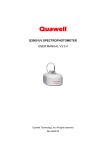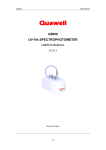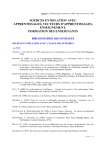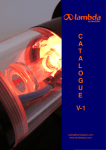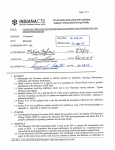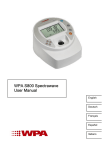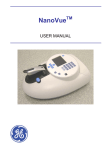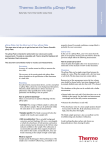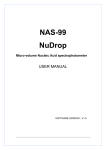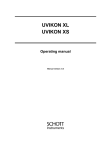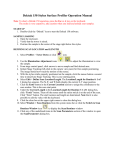Download Quawell - Lab Supplies Scientific
Transcript
Quawell Q3000 UV SPECTROPHOTOMETER USER MANUAL V3.1.1 Quawell Technology, Inc. All rights reserved Rev 08/2011 Quawell Q3000 USER MANUAL Table of Contents 1 OVERVIEW ............................................................................................... 5 Introduction.................................................................................... 5 Basic operation ......................................................................................... 5 Patents and unique technologies............................................................... 6 2 INSTALLATION……………………………………………………………… 8 Computer requirements ........................................................................... 8 Software setup ……………………………………………………………… 8 Install Q3000 and the driver ……………………………………....………… 8 Input CCE No……………………...…………………………………………. 8 3 MENU AND FUNCTIONS FOR THE APPLICATIONS……………….…… 9 Menu…………………………………………………………………………….. 9 Buttons on the menu………………………………………………….….....10 Password………….…………………………………………………………...10 Functions for Nucleic Acid and Protein A280………………………….….10 Making measurement……………………….……………………………...…11 4 NUCLEIC ACIDS...……………………………………………………………12 Nucleic acid screen features……………………………………………… 12 Sample ID - #............................................................................................12 Sample Type - E Coe……………………………………………………........12 Ads260……………………………………………………………………........12 Abs280………………………………………………………………………... 12 260/280……………………………………………………………………. 12 ng/ul………………………………………………………………………….... 12 2 Quawell Q3000 USER MANUAL Measurement range……………………………………………………….. 13 Sample Volume………………………………………………..………….….. 13 5 PROTEIN A280……………………………………………………………… 14 Nucleic acid screen features………………………………………………... 14 Sample ID - #.......................................................................................... 14 Sample Type..............………………………………………………….……. 14 Ads260………………………………………………………………………… 14 Abs280………………………………………………………………………… 14 260/280……………………………………………………………………….. 14 mg/ml………………………………………………………………………… 14 Measurement range………………………………………………………… 15 Sample Volume………………………………………………..………….….. 15 6 POTENTIAL SOURCES OF ERROR…………………………………….. 16 Sample overlap…………………………………………………………….… 16 Sample homogeneity…………………………………………………….….. 16 Effect of evaporation………………………………………………………… 17 Insufficient sample volume…………………………………………………. 17 7 TROUBLESHOOTING ……………………………………………………. 18 Q3000 driver installation error………………….....………………………… 18 USB connection error………………………………………………………… 18 Sample accuracy and reproducibility ....................................................... 19 8 MAINTENANCE AND CALIBRATION……….….………………………… 20 Maintenance ........................................................................................... 20 Check the calibration (not available)........................................................ 20 The procedure for checking the calibration (not available)....................... 20 9 APPENDICES………………………………………………………………… 21 3 Quawell Q3000 USER MANUAL A. Instrument specifications……………………………………………….. 21 B. Absorbance calculation…………………………………………………. 22 C. Concentration calculation (Beer’s Law) ……………………………… 23 D. Contact information............................................................................. 24 4 Quawell Q3000 USER MANUAL 1. OVERVIEW Introduction Quawell Q3000 is a micro-volume UV spectrophotometer specifically designed for the measurement of nucleic acids and pure proteins. Using a unique technology that holds 1-2 ul samples between the upper and lower optical surfaces without the use of a cuvette, Q3000 has ability to measure the sample in less than 2 seconds with a high degree of accuracy and reproducibility. Basic operation Operation of the Q3000 is simple and efficient. The Q3000 uses the technologies that automatically make all necessary measurements and calculations. The data is presented in the module data window and is easily exported to an Excel spreadsheet. To operate: 1. Lift the upper arm, place 1.5ul blank buffer to the lower surface. 2. Lower the upper arm and click the “Blank” button. 3. Lift the upper arm and wipe the blank buffer from both surfaces. 4. Place 1.5ul sample on the lower surface, set the upper arm back to the measurement position and click the “Measure” button. 5 Quawell Q3000 USER MANUAL Patents and unique technologies The liquid column technologies (Patent No. US 7,969,575 B2): Q3000 is built base on the following liquid column technologies Figure 1: Initially the sample is loaded and the upper arm is closed. Figure 2: The upper arm is lifted by the actuator, due to molecular effects, the sample is broken into two separate parts, one part is attached to lower surface and the other part is attached to upper surface. Figure 3: After reaching its home position, the upper arm is lowered. A liquid column is formed when the upper arm is lowered to the position where the two droplets touch. The measurement is then performed at this position without moving the upper arm upwardly again. CCE No. (Patent pending) CCE No. (Calibration Coefficient) is another unique technology used in Q3000 software. With CCE No., Q3000 has ability to: 1. Automatically calibrate by running “Diagnostic” module (option). 2. Provide higher accuracy then the similar products in the market. 6 Quawell Q3000 USER MANUAL The light system (Patent pending) The light system designed especially for Q3000 has many advantages: 1. long life time 2. reproducibility 3. efficient 7 Quawell Q3000 USER MANUAL 2. INSTALLATION Note: Do not connect the instrument to the PC before software install. Computer requirements Microsoft Windows XP, Vista or Windows7 Microsoft Office 2003 or higher Adobe Reader CPU: 400MHZ or higher 64MB RAM USB port Monitor 1024x768 500MB Hard disk available Software Setup Insert the CD into the CD-ROM, open the folder “Q3000”, double click the file “Setup”, and follow the prompts to finish installation of the software. Install Q3000 and the Driver Connect the instrument to the PC using the USB cable shipped with the Q3000, the computer will automatically find the drive and finish the installation. Input CCE No. For first time to use, it is required to input the CCE No. Note: wrong CCE No. input will cause the measurement error. 8 Quawell Q3000 USER MANUAL 3. MENU AND FUNCTIONS FOR THE APPLICATIONS Menu Double click the shortcut Q3000 on the desktop, the menu as below will be displayed on the screen. Buttons on the menu: 1. Nucleic Acid: the application for samples of dsDNA, ssDNA and RNA. 2. Protein A280: the application for sample of pure proteins (BSA, IgG and Lysozyme). 3. Edit CCE No.: allows the users to edit CCE No. when it is necessary. 4. User Manual: display the user manual by click the button. 5. Change Password: change the password that is required for edit CCE No. 6. Diagnostic: check the calibration. 9 Quawell Q3000 USER MANUAL Password Password is required for edit CCE No. The default password is “admin”. The user can edit the password using “Edit Password”. Functions for Nucleic Acid and Protein A280 There are six function buttons for the applications of Nucleic Acid and Protein A280. 1. Function button Exit: exit the current application and back to the menu. 2. Function button Quick Ref: display the quick reference for sample measurement. 10 Quawell Q3000 USER MANUAL 3. Function button Blank: measure and store the blank values for the sample to be measurement. 4. Function button Clear Data: clear the data records on the Data Table. 5. Function button Export To Excel: output the data on the Data Table to Excel spreadsheet. 6. Function button Measure: measures and calculates the sample absorbance and concentration. See Appendices B and C for details on the absorbance and concentration calculations. Making measurement 1. Select the sample type and input the sample ID for the sample to be measured. 2. Open the upper arm, add 1.5ul blank reagent on the lower surface and close the upper arm. 3. Click the button “Blank”. 4. Left the upper arm and clean the blank reagent from both upper and lower surfaces with the dry wrapper. 5. Add 1.5ul sample on the lower surface and close the upper arm. 6. Click the button “Measure” 7. Clean the sample with dry wrap 8. Export the data if you need to save it. 11 Quawell Q3000 USER MANUAL 4. NUCLEIC ACIDS Nucleic acid screen features Select Nucleic Acid application from the Q3000 menu, the module interface will be displayed on the screen as below. Sample ID - #: there are two windows that display the sample ID information. The left window displays the sample ID input by the user. The default is “My Sample”. The right window displays the ID number for that sample ID. The ID number begins at 1 and increases by 1 for each measurement. Changing the Sample ID will automatically reset the ID number to 1. 12 Quawell Q3000 USER MANUAL Sample Type: Chose the sample type for the sample to be measured. There are 3 different sample types for nucleic acids: dsDNA, ssDNA and RNA. The default is dsDNA. The sample type is disabled after blanking, The extinction coefficient of the sample selected will appear in the next window on the right. Ads260: Absorbance of the sample at 260 nm. Abs280: Absorbance of the sample at 280 nm. 260/280: Ratio of absorbance at 260 nm and 280 nm. ng/ul: Sample concentration in ng/ul. See Appendix C for more details on this calculation. Measurement range (dsDNA) Concentration Reproducibility 1 to 4000 ng/ul 1-100 ng/ul 2 >100 ng/ul 2% Abs accuracy(1mm) ul 2% Sample Volume There is no specific requirement for the sample volume; however for the best accuracy and reproducibility we recommend 1.5ul. 13 Quawell Q3000 USER MANUAL 5. PROTEIN A280 Protein A280 screen features Select Protein A280 from the Q3000 menu. The module interface will appear on the screen. Sample ID - #: there are two windows that display the sample ID information. The left window displays the sample ID input by the user. The default is “My Sample”. The right window displays the ID number for that sample ID. The ID number begins at 1 and increases by 1 for each measurement. Changing the Sample ID will automatically reset the ID number to 1. Sample Type: Chose the sample type for the sample to be measured. There are 4 different sample types for protein measurement: 1Abs = 14 Quawell Q3000 USER MANUAL 1mg/ml, BSA, IgG, and Lysozyme. The default is 1Abs = 1mg/ml. The sample type is disabled after blanking. The extinction coefficient of the sample selected will appear in the E Coe window. Ads260: Absorbance of the sample at 260 nm. Abs280: Absorbance of the sample at 280 nm. 260/280: Ratio of the absorbance at 260 nm and 280 nm. mg/ml: Sample concentration in mg/ml. See Appendix C for more details on this calculation. Measurement range (BSA): Concentration Reproducibility Absorbance accuracy(1mm) 0.05 -100 mg/ml 2% Abs 0-0.2 0.002abs Abs 0.2-1 0.02abs Sample Volume There is no specific requirement for the sample volume; however for the best accuracy and reproducibility we recommend 1.5ul. 15 Quawell Q3000 USER MANUAL 6. POTENTIAL SOURCES OF ERROR Sample overlap Sample residue on either measurement surface will affect the result. We suggest that the user: 1. Clean the two surfaces with dry soft lab paper after each sample measurement. 2. Use 2 ul of de-ionized water to clean the surfaces after measuring highly concentrated samples. 3. Thoroughly clean the surfaces and surrounding area with de-ionized water after completing all measurements. 4. Before sample measurement, blank the machine as described: Open the appropriate application module. Lift the upper arm and add 2 ul of blanking reagent to the lower surface. Lower the upper arm and click the Blank button. Lift the upper arm and clean the blanking reagent from both surfaces with de-ionized water. Add 2 ul blanking reagent to the lower surface. Lower the upper arm and click the Measure button. If the value is higher than 0.04, repeat steps b to f. Sample homogeneity Non-homogenous samples would cause significant deviation in the data generated by any measurement system, including the spectrophotometer. 16 Quawell Q3000 USER MANUAL Effect of evaporation Sample evaporation could cause a 1-2% deviation in the sample’s concentration. Insufficient sample volume We recommend 2ul for normal sample measurements. This sample size ensures that the liquid sample forms a complete column between the upper and lower optical surfaces. 17 Quawell Q3000 USER MANUAL 7. TROUBLESHOOTING Q3000 driver installation error To solve this problem by manually install the driver as follows: 1. Disconnect Q3000 2. Insert the CD into CD-ROM, click the driver “CP210xVCPInstaller” in following folder: C:\Program Files\Quawell\Q3000 V3.0.1\SiLabs\MCU \CP210x. 3. Connect Q3000 to computer with the USB cable. 4. If there is still a problem with the driver installation, please contact technical support at (408) 676-7626. USB connection error This error screen appears when there is a communication problem between the Q3000 and the computer. It usually indicates that the Q3000 and PC connection failed. To correct the error, unplug the USB cable, wait for 2-3 seconds, and plug it again, or contact technical support. 18 Quawell Q3000 USER MANUAL Sample accuracy and reproducibility If the sample data are inaccurate and/or not reproducible please refer to Section 6 “POTENTIAL SOURCES OF ERROR”. 19 Quawell Q3000 USER MANUAL 8. MAINTENANCE AND CALIBRATION Maintenance The primary maintenance requirement of the Q3000 spectrophotometer is to keep the measurement surfaces clean. Upon completion of measurement, to prevent sample carryover and residue buildup, wipe the sample from the upper and lower measurement surfaces, as well as the surrounding area, with de-ionized water. Check the calibration (Option) The Diagnostic function checks the instrument calibration. It is recommended that run this function every six months. Quawell CR101 is required to run the “Diagnostic” function. You can order CR101 through Quawell or your local distributor. CR101 is an aqueous potassium dichromate (K2Cr2O7) solution. 20 Quawell Q3000 USER MANUAL 9. APPENDICES A. Instrument specifications Path length: 0.2 mm to 1mm, auto-selected Sample size requirement: 1.5 ul Light source: LED Detector: photoelectric cell Wavelength range: 260nm, 280nm Wavelength accuracy: < 2 nm Absorbance precision: 0.001 Abs Accuracy: <100ng/ul 2ng/ul, >100ng/ul 2% Absorbance range: 0-80 A Concentration range: 0-4000 ng/ul (dsDNA) Measurement cycle time: 2s Dimension: 20 cm x 15 cm x 12 cm Sample pedestal material: stainless steel Optical fiber material: quartz Operating voltage: 12V Operation power consumption: < 10 W Standby power consumption: <3W CE: Ready 21 Quawell Q3000 USER MANUAL B. Absorbance calculation When the Q3000 Spectrophotometer is “blanked”, a spectrum is taken of a reference material (blank) and stored in memory as an array of light intensities by wavelength. When a measurement of a sample is taken, the intensity of light that has transmitted through the sample is recorded. The sample intensities along with the blank intensities are used to calculate the sample absorbance according to the following equation: I sample Abs log I blanc Thus, the measured light intensity of both the sample and of the blank are required to calculate the absorbance at a given wavelength. 22 Quawell Q3000 USER MANUAL C. Concentration Calculation (Beer’s Law) The Beer-Lambert equation is used to correlate the calculated absorbance with concentration: A=E*b*c Where A is the absorbance represented in absorbance units (A), E is the wavelength-dependent molar absorptivity coefficient (or extinction coefficient) with units of liter/mol-cm, b is the path length in cm, and c is the analyte concentration in moles/liter or molarity (M). 23 Quawell Q3000 USER MANUAL D. Contact Information Quawell Technology, Inc. P.O. Box 612738 San Jose, CA 95161-2738 USA Tel: (408)329-6241 www.quawell.com Service and technical support Tel: (408) 838-3919 Note: All information in this user manual is believed to be correct and complete and is subject to change without notice. 24
























